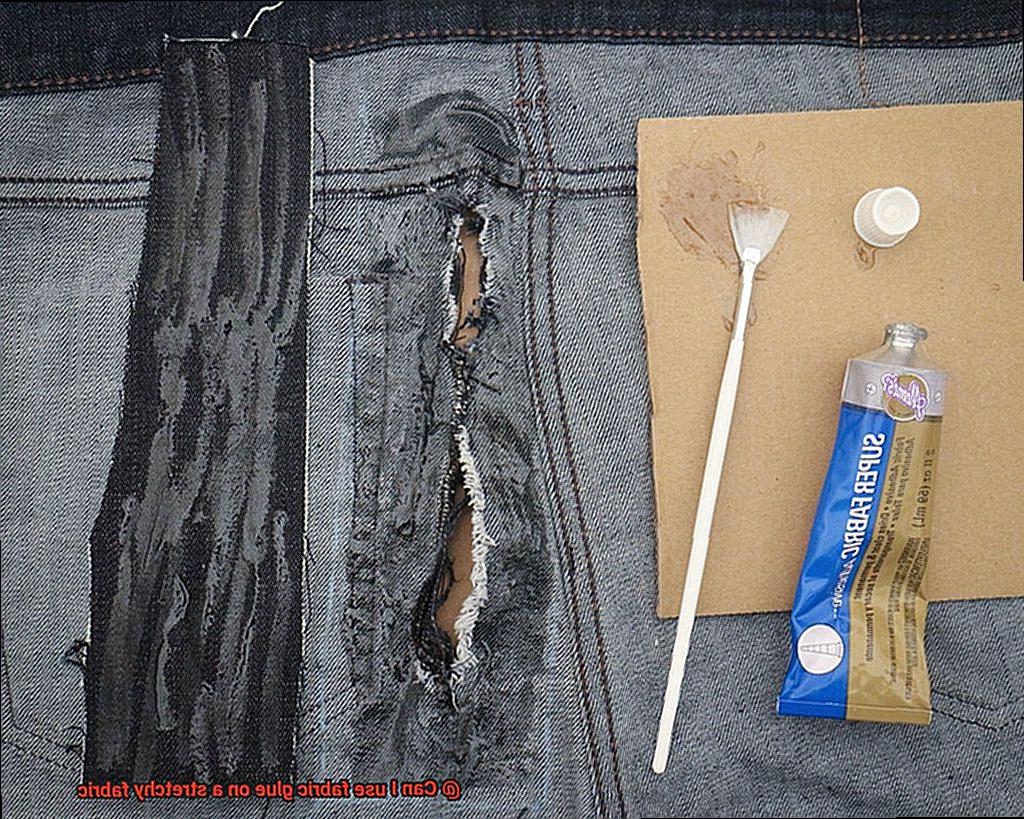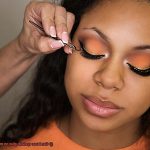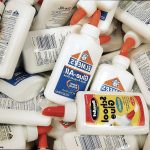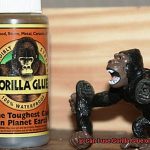Got a stretchy fabric that’s begging for some love? Wondering if fabric glue is the answer to your creative dreams? Well, fear not, because in this blog post, we’re diving into the wonderful world of using fabric glue on stretchy fabrics. Get ready for some pros, cons, and all the juicy details you need to know.
Pros:
Let’s talk about why fabric glue can be a game-changer for stretchy fabrics. Sewing or hemming these materials can sometimes mess with their elasticity and overall look. That’s where fabric glue swoops in like a superhero.
It allows you to precisely apply it to seams, hems, or embellishments with ease. Plus, it dries super fast, saving you from spending hours on stitches. Oh, and did I mention that it can survive machine-washing and drying without losing its grip? Talk about convenience.
Cons:
Before you go all-in on the fabric glue train, let’s consider the cons too. Some glues might leave behind residue or even stain your precious fabrics. Yikes. To avoid any mishaps, always do a small test on an inconspicuous area first.
And here’s another thing – while fabric glue is pretty durable, it might not hold up as well as traditional sewing over time. Especially when your stretchy masterpiece faces lots of stretching or high-temperature washes.
Tips and Tricks:
Now that we’ve got both sides of the story covered let’s move on to some tips and tricks for successful fabric glue adventures with stretchy fabrics. First off, make sure to grab a bottle of fabric glue specifically designed for these materials – look out for labels like “fabric glue” or “stretch glue.” Next up, use the glue sparingly – too much can make your fabric stiff or cause some icky build-up.
And last but not least, prep your fabric by ensuring it’s clean, dry, and free from any oils or residues that might mess with the glue’s powers.
Factors to Consider When Using Fabric Glue on Stretchy Fabrics
Contents
- 1 Factors to Consider When Using Fabric Glue on Stretchy Fabrics
- 2 Types of Fabric Glue Suitable for Stretchy Fabrics
- 3 Application Method for Using Fabric Glue on Stretchy Fabrics
- 4 Advantages and Disadvantages of Using Fabric Glue on Stretchy Fabrics
- 5 Testing the Adhesive Before Applying it to the Entire Fabric
- 6 Alternatives to Using Fabric Glue on Stretchy Fabrics
- 7 Conclusion
Working with stretchy fabrics can be a challenge, but using fabric glue can make the task easier and more convenient. However, it’s crucial to consider several factors to ensure successful results. In this comprehensive guide, we will explore the key factors that will help you achieve a strong and flexible bond while preserving the integrity of your stretchy fabrics.
Know Your Fabric:
Understanding the type of fabric you’re working with is essential. Fabrics like spandex, jersey, and knits have high elasticity, making them difficult to bond with glue. Before using fabric glue, consider the composition and stretchiness of the fabric to ensure compatibility.
Choose the Right Glue:
Not all fabric glues are created equal, especially when it comes to stretchy fabrics. Look for glues specifically designed for stretchable materials or those labeled as “flexible” or “stretchable.” These specialized glues contain additives that maintain a strong bond without compromising the fabric’s elasticity.
Bond Strength and Flexibility:
The strength of the bond is crucial when working with stretchy fabrics. Opt for fabric glues that offer a strong adhesive property while remaining flexible. Avoid glues that become brittle or stiff when dried, as they can affect the stretchiness of the fabric.
Patience is Key:
Stretchy fabrics require longer drying times compared to non-stretchy fabrics. Follow the manufacturer’s instructions regarding drying time for optimal results. Rushing the process may result in a weaker bond or damage to the fabric.
Washability Matters:
Consider how washable you need your glued fabric to be. Some fabric glues are water-resistant or machine-washable, while others may not hold up well in water or when exposed to heat. Choose a fabric glue that can withstand repeated washes without losing its adhesive properties.
Test Before Application:
Perform a small test on an inconspicuous area of the fabric before applying fabric glue to your project. This will help determine the glue’s compatibility with the fabric, bond strength, and flexibility. Testing will prevent any mishaps or damage to your fabric.

Care Instructions:
Be aware of any special care instructions for both the fabric and the fabric glue. Some glues may require specific treatment or have limitations, such as avoiding high heat or dry cleaning. Following the care instructions will maintain the durability and longevity of your glued stretchy fabric.
Types of Fabric Glue Suitable for Stretchy Fabrics
Here, we’ll explore different types of fabric glue suitable for stretchy fabrics. So grab your glitter and let’s get started.
Fabric Adhesive Spray:
This spray-on glue is perfect for stretchy fabrics because it allows flexibility and movement. Unlike traditional glues that can make fabrics stiff or rigid, fabric adhesive spray maintains the natural stretchiness of the fabric. You can easily reposition the fabric if needed, making it a versatile choice. Just spritz it on, position your pieces, and voila
Fabric Glue Stick:
Looking for precision? A fabric glue stick is your go-to. It comes in a solid stick form, just like your favorite colored pencil. Simply apply the glue directly onto the fabric and watch it dry clear and flexible. The advantage of using a glue stick is that it provides more control over where the glue is applied.
This makes it perfect for small projects or when you need to attach embellishments to stretchy materials. It’s like having a magic wand in your craft kit. With a fabric glue stick in hand, you can create intricate designs without worrying about the glue seeping through or leaving visible marks.
Liquid Fabric Glue:
For those who enjoy the brush stroke of creativity, liquid fabric glue is a fantastic choice. With a brush or applicator, you can smoothly apply this glue onto your stretchy fabrics. The best part? It dries flexible and stretchy too. It’s like painting with glue
an artist’s dream. Liquid fabric glue is ideal for larger projects that require a strong and lasting bond. Whether you’re creating a custom-made swimsuit or adding appliques to your workout gear, liquid fabric glue will provide a reliable hold without compromising the fabric’s elasticity.
Read the Labels:
Before diving into the glue pool, remember to read the labels. Look for glues specifically designed for stretchy fabrics. These glues have special ingredients that help maintain the fabric’s elasticity while creating a strong bond. Keep an eye out for phrases like “stretchable” or “flexible” on the packaging.
By choosing a glue that is specifically formulated for stretchy fabrics, you can ensure that your creations will withstand the test of time and movement.
Application Method for Using Fabric Glue on Stretchy Fabrics
Stretchy fabrics are a beloved staple in the world of fashion and DIY projects. They offer unparalleled comfort, flexibility, and a flawless fit. But what if you want to join two pieces of stretchy fabric together without resorting to sewing?
Fabric glue is here to save the day. In this comprehensive guide, we will delve into the correct application method for using fabric glue on stretchy fabrics. With these expert tips, you can unleash your creativity without compromising the integrity of your garments.
Preparation is Key:
Before embarking on the gluing process, it is crucial to prepare your stretchy fabric properly. Give it a thorough prewash and dry to eliminate any lingering chemicals or finishes that might interfere with the adhesive. This simple step ensures a pristine surface for the glue to work its magic.
Test-Run for Success:
To avoid any unforeseen mishaps, always conduct a test-run by applying a small amount of fabric glue to an inconspicuous area of your fabric. This trial will determine whether the glue is compatible with the fabric and if there are any chances of discoloration or damage. Remember, it’s better to be safe than sorry.
The Art of Application:
Now that your fabric is primed and ready, it’s time to dive into the application process. Here’s a step-by-step breakdown:
- Prepare your workspace by laying your stretchy fabric on a flat and stable surface. For added precaution, place a protective layer underneath to prevent any unwanted sticking.
- Begin by squeezing a modest amount of fabric glue onto one side of the fabric near the edge. Remember, less is more at this stage. You can always add more if needed.
- To ensure an even distribution of glue, employ a small brush or even a toothpick if precision is your thing. Make sure to cover the entire area where you plan to bond the fabric together.
- With utmost care, fold or position the other side of the fabric over the glued area, exerting firm pressure for a strong bond.
- To allow the adhesive to set properly, hold or clamp the glued area in place for a few minutes. This simple step guarantees that your creation will stay intact.
- After giving it sufficient drying time, inspect the fabric for any areas that may require additional glue. Apply more fabric glue if needed, and repeat the pressing and clamping process.
- The grand finale: Allow the fabric glue to fully dry according to the manufacturer’s instructions before wearing or washing the garment. This final step ensures a long-lasting bond that will withstand the test of time.
Advantages and Disadvantages of Using Fabric Glue on Stretchy Fabrics
Stretchy fabrics are highly sought after for their comfortable fit and versatility in various garments and crafts. When it comes to joining these fabrics together, fabric glue offers a convenient alternative to traditional sewing methods.
In this comprehensive article, we will delve into the advantages and disadvantages of using fabric glue specifically on stretchy fabrics. By examining the pros and cons, you will be equipped to make an informed decision for your next project.
Advantages:
- Ease of Use: Fabric glue simplifies the process of bonding stretchy fabrics by eliminating the need for sewing or stitching. With a simple application directly onto the fabric, the pieces can be pressed together for a secure bond.
- Time-Saving: Unlike time-consuming sewing techniques, fabric glue allows for quick repairs or alterations. This is particularly advantageous when working with delicate or intricate designs that can be challenging to sew.
- Versatility: Fabric glue proves compatible with a wide range of stretchy fabrics, including jersey, spandex, and Lycra. Furthermore, it adheres well to different materials such as cotton, polyester, and silk blends, making it suitable for a diverse array of projects.
- Invisible Results: When applied correctly, fabric glue dries clear and becomes nearly invisible on the fabric. This seamless finish ensures that the final product appears professional and flawless.
Disadvantages:
- Limited Durability: While fabric glue provides a quick fix, it may not offer the same level of durability as traditional sewing methods. Over time or with repeated washing, the adhesive may weaken, potentially causing the fabric to come apart.
- Lack of Flexibility: Stretchy fabrics require freedom of movement to maintain their elasticity and comfort. However, fabric glue can occasionally stiffen the fabric or restrict its natural flexibility, making it less pleasant to wear.
- Potential Staining: Some fabric glues may leave behind residue or stains if they are not specifically formulated for use on stretchy fabrics. To avoid this issue, it is crucial to select high-quality fabric glue that is designed to be non-staining.
- Limited Repositioning: Once fabric glue has dried, it becomes challenging to reposition or make adjustments. Any mistakes made during the gluing process cannot be easily rectified without potentially damaging the fabric.
Testing the Adhesive Before Applying it to the Entire Fabric
Fabric glue is a game-changer for sewing-free fabric joining, especially with stretchy fabrics. However, not all fabric glues are created equal, making it crucial to test them before applying them to your entire fabric.
By doing so, you can ensure a robust bond while safeguarding your fabric from potential damage. In this article, we will explore the importance of testing adhesive for stretchy fabrics, how to conduct the test, the best adhesive types for stretchy materials, and essential safety precautions.
Why Test the Adhesive?
Different fabric glues can react differently with stretchy materials, making it vital to test their suitability. By testing a small area of your fabric, you can determine if the glue will withstand tension and stretching, ensuring long-lasting results. This step becomes even more critical when working with delicate or expensive fabrics.
How to Test the Adhesive:
To test the adhesive, choose an inconspicuous area like an inside seam or hemline. Apply a small amount of fabric glue and follow the manufacturer’s instructions for drying time. Once dry, gently stretch the fabric in various directions to check if the glue remains intact.
If the adhesive holds up without cracking or peeling, it is likely suitable for your project. However, if it weakens or fails under tension, consider an alternative glue or method.
Best Adhesive Types for Stretchy Fabrics:
Specifically formulated fabric glues for stretchy fabrics offer superior adhesion properties. These glues contain additives that allow them to flex and move with the fabric without compromising their bond.
When working with highly stretchy materials, opt for specialized stretch fabric glues for optimal results.
Safety Precautions:
While fabric gluing is generally safe, it’s essential to take precautions. Work in a well-ventilated area to avoid inhaling fumes. In case of contact with skin or eyes, rinse thoroughly with water. Store adhesive products out of reach of children and pets.
Alternatives to Using Fabric Glue on Stretchy Fabrics
Here, I will introduce you to some fantastic alternatives that will make your life easier and your projects more seamless. So, let’s dive in and explore these incredible alternatives to fabric glue.
Fabric Tape:
Fabric tape is a game-changer when it comes to working with stretchy fabrics. It’s easy to use and provides a strong bond. Simply cut the tape to the desired length, peel off the backing, and place it between the layers of fabric. You have a secure bond. With different widths available, fabric tape is a must-have in your crafting arsenal.
Fusible Webbing:
Another fantastic alternative is fusible webbing. This thin adhesive sheet can be ironed onto the fabric to create a strong bond. Cut it to size, place it between the fabric layers, and use a hot iron to melt the adhesive. Follow the manufacturer’s instructions for best results. Fusible webbing is a reliable option that ensures durability.
Sewing:
When in doubt, sew it out. Sewing is one of the most reliable alternatives for fabric glue on stretchy fabrics. Using a sewing machine or hand sewing, you can create a secure and long-lasting bond. Use a needle specifically designed for stretch fabrics and opt for a stretch stitch or zigzag stitch to allow for flexibility. Sewing not only provides strength but also allows for easier alterations or repairs in the future.
Heat Bonding:
For those seeking a permanent bond that can withstand washing and stretching, heat bonding is the way to go. This technique involves using heat and pressure to fuse two fabrics together.
You’ll need a heat press machine or an iron with adjustable temperature settings. Place a heat-bonding adhesive between the fabric layers and apply heat and pressure according to the manufacturer’s instructions. Heat bonding is a reliable option for durability.
Fabric Fasteners:
If you prefer versatility, fabric fasteners such as snaps, buttons, or hook-and-loop closures are perfect. These fasteners provide a secure closure while allowing for flexibility and movement. Attach snaps using a snap press or pliers, sew buttons on using a needle and thread, or use hook-and-loop closures (Velcro) that can be sewn or adhered to the fabric using the adhesive backing.
J2TXx1Y_Km0″ >
Conclusion
In conclusion, fabric glue is a convenient and time-saving option for working with stretchy fabrics. It offers ease of use, saves you precious time, and provides versatility in joining or embellishing materials. When applied correctly, fabric glue can create an invisible finish that seamlessly blends with the fabric.
However, it’s important to be aware of some potential drawbacks. Fabric glue may not be as durable as sewing and can result in stiffness or lack of flexibility in the fabric. To avoid staining, it’s crucial to use a non-staining glue.
Additionally, once the glue has dried, repositioning becomes difficult.
To ensure successful results when using fabric glue on stretchy fabrics, consider several factors. First, choose a glue specifically designed for stretchable materials and take into account the type of fabric being used. It’s essential to achieve a strong and flexible bond by allowing sufficient drying time.
Consider washability requirements and perform a small test before applying the glue to the entire fabric. Lastly, follow care instructions for both the fabric and the chosen fabric glue.
If you prefer alternatives to fabric glue for stretchy fabrics, there are reliable options available. Fabric tape, fusible webbing, sewing techniques using stretch stitches, heat bonding techniques with a heat press machine or iron with adjustable temperature settings, and fabric fasteners like snaps or buttons can all provide durable results.
Ultimately, whether you choose to use fabric glue or explore alternative methods depends on your specific project needs and personal preferences. By considering these factors and employing proper techniques, you can achieve beautiful results with your stretchy fabric creations. So go ahead and let your creativity soar.






